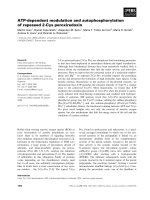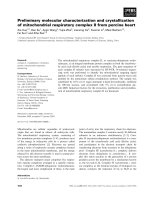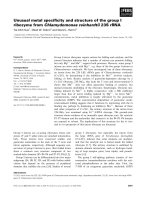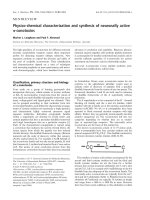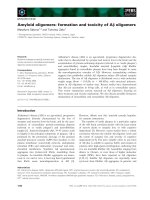Báo cáo khoa học: "Photosynthesis, leaf area and productivity of 5 poplar clones during their establishment year" potx
Bạn đang xem bản rút gọn của tài liệu. Xem và tải ngay bản đầy đủ của tài liệu tại đây (647.66 KB, 13 trang )
Original
article
Photosynthesis,
leaf
area
and
productivity
of
5
poplar
clones
during
their
establishment
year
TS Barigah
B
Saugier
M
Mousseau
J
Guittet
R
Ceulemans
3
1
INRA,
Station
de Recherches
Forestières,
BP
709,
97387
Kourou
cedex;
2
Université
de
Paris
XI,
Laboratoire
d’Écologie
Végétale,
Centre
d’Orsay,
Bâtiment 362, 91405 Orsay cedex,
France;
3
Université
d’Anvers,
Département
Biologie,
UIA,
Universiteitsplein
1,
B-2610
Wilrijk,
Belgium
(Received
3
November
1993;
accepted
24
March
1994)
Summary —
The
stem
volume
and
biomass
(stem
+
branches)
production,
net
photosynthesis
of
mature
leaves
and
leaf
area
production
of
5
poplar
(Populus)
clones,
Populus
trichocarpa
x
deltoides
(Raspalje
and
Beaupré),
Populus
x euramericana
(Robusta)
and
P
trichocarpa
(Columbia
River
and
Fritzi
Pauley),
were
studied
during
the
first
year
of
growth
in
an
experimental
high
density
plantation
(15 600
plants
ha-1).
Significant
differences
were
found
in
volume
production,
woody
biomass
production,
total
leaf
area
and
net
photosynthesis.
Above-ground
biomass
production
was
3.5
times
higher
in
Raspalje
than
in
Robusta.
The
best
performing
clones
(Raspalje,
Beaupré)
were
those
with
large
leaves,
high
leaf
area
index
and
high
photosynthetic
rates.
A
positive
relationship
between
leaf
photo-
synthetic
capacity
and
above-ground
biomass
production
was
also
noted
for
4
of
the
5
clones.
The
euramerican
clone
Robusta
was
an
exception,
showing
high
photosynthetic
rates,
but
low
biomass
pro-
duction.
This
discrepancy
was
mainly
due
to
the
lower
leaf
area
of
this
clone,
and
possibly
also
due
to
a
larger
carbon
allocation
to
below-ground
biomass
(Barigah,
1991).
The
root/shoot
ratios
at
the
end
of
the
first
season
in
the
clones
Raspalje
and
Robusta
were
1.23
and
1.79,
respectively.
net
photosynthesis
/
leaf
area
/
biomass
production
/
Populus
Résumé —
Photosynthèse,
surface
foliaire
et
productivité
de
5
clones
de
peuplier
dans
leur
pre-
mière
année.
Des
plants
issus
de
boutures
de
5
clones
de
peuplier
(Populus
trichocarpa
x
deltoides
(Raspalje
et
Beaupré),
P
x euramericana
(Robusta)
et
P
trichocarpa
(Columbia
River
et
Fritzi
Pauley)
ont
été
cultivés
en
peuplement
dense
(15 600
tiges
ha-1).
Des
mesures
d’assimilation
de
CO
2
et
de
crois-
sance
(surface
foliaire,
volume
de
tiges,
biomasse
aérienne)
ont
été
réalisées
sur
les
jeunes
plants.
L’ac-
cumulation
de
biomasse
du
clone
le
plus
performant
(Raspalje)
représentait
3,5
fois
celle
observée
dans
le
clone
le
moins
performant
(Robusta).
Les
clones
les
plus
performants
(Raspalje,
Beaupré)
étaient
également
caractérisés
par
une
surface
foliaire
importante
et
une
assimilation
nette
foliaire
élevée.
Les
différences
de
surface
foliaire
entre
clones
étaient
liées
à
des
différences
de
surface
individuelle
des
feuilles
et
non
au
nombre
de
feuilles
par
arbre,
qui
était
quasi
constant.
La
biomasse
aérienne
était
posi-
tivement
corrélée
à
la
capacité
photosynthétique
foliaire
pour
4
clones.
Cependant
le
clone
Robusta,
de
capacité
de
production
faible,
présentait
une
photosynthèse
foliaire
élevée.
Cette
faible
production
de
biomasse
aérienne
chez
Robusta
était
due
à
un
faible
développement
foliaire
et
probablement
aussi
à
un
investissement
en
biomasse
racinaire
important
(Barigah,
1991) ;
le
rapport
de
la
bio-
masse
racinaire
à
la
biomasse
aérienne
était
respectivement
de
1,23
et
de
1,79
pour
les
clones
Ras-
palje
et
Robusta.
photosynthèse
foliaire / surface
foliaire
/ production
de
biomasse
/ Populus
INTRODUCTION
Plant
productivity
depends
on
the
interac-
tion
of
light
intercepting
the
leaf
area
of
a
plant
and
the
intensity
of
the
CO
2
assimila-
tion
process
taking
place
in
those
leaves.
The
production
of
forest
stands
has
been
shown
to
be
strongly
correlated
with
total
annual
intercepted
irradiance
(Linder,
1984;
Beadle
and
Long,
1985).
Differences
in
the
amount
of
leaf
area
displayed
or
in
the
inten-
sity
of
the
photosynthetic
rate
will
result
in
different
biomass
productivity
rates.
Photosynthetic
capacity
is
known
to
vary
widely
among
tree
species,
usually
being
higher
in
deciduous
than
in
coniferous
trees
(Ceulemans
and
Saugier,
1991).
In
several
tree
species,
intensive selection
for
increased
biomass
productivity
has
resulted
in
hybrids
demonstrating
heterosis
for
photo-
synthetic
performance
(Isebrands
et
al,
1988).
Moreover,
a
positive
correlation
between
photosynthetic
capacity
and
biomass
productivity
has
already
been
demonstrated
for
poplar
hybrids
(Ceule-
mans
and
Impens,
1983;
Michael
et
al,
1990),
larch
hybrids
(Matyssek
and
Schulze,
1987)
and
different
provenances
of
loblolly
pine
(Boltz
et al,
1986).
However,
in
many
other
cases,
net
photosynthesis
rate
measurements
have
been
found
to
be
poorly
correlated
with
growth
rate
and
productivity,
such
as
in
the
case
of
Populus
grandidentata,
P
tremu-
loides
and
P
smithii
(Okafo
and
Hanover,
1978;
Reighard
and
Hanover,
1990).
These
conflicting
results
are
due
to
the
difficulty
of
measuring
the
gas
exchange
rate
on
com-
parable
leaves
in
different
genotypes,
to
phenological
and
physiological
changes
dur-
ing
the
growing
season,
and
to
the
distri-
bution
of
photosynthates
within
the
tree.
For
example,
some
poplar
clones
retain
green
leaves
late
in
the
fall
with
a
measurable
photosynthetic
production
even
after
frosts,
thus
contributing
significantly
to
a
late
sea-
son
stem
diameter
increment
(Nelson
et al,
1982)
and
root
growth
(Isebrands
and
Nel-
son,
1983).
In
addition
to
photosynthetic
rate,
leaf
area
is
also
a
very
important
determinant
of
biomass
productivity.
Comparing
differ-
ent
spruce
(Picea
abies)
provenances
Gross
and
Hettesheimer
(1983)
found
a
negative
correlation
between
leaf
area
and
both
biomass
production
of
the
trees
and
CO
2
assimilation
rate.
The
relationship
between
biomass
productivity
and
its
determining
factors
may
thus
be
complicated.
Never-
theless,
variability
in
plant
genotypes
accord-
ing
to
plant
branchiness
and
leaf
distribu-
tion,
position
and
orientation
within
the
crown
could
strongly
influence
the
efficiency
of
conversion
of
solar
energy
into
biomass
pro-
duction
(Isebrands
and
Nelson,
1982;
Ise-
brands
and
Michael,
1986).
However,
direct
linear
relationships
between
biomass
pro-
duction
and
solar
radiation
intercepted
by
the
foliage
have
been
demonstrated
in
agri-
cultural
crops
(Monteith,
1981)
as
well
as
in
forest
stands
(Linder,
1984;
Leverenz
and
Hinckley,
1990).
Although
this
simple
rela-
tionship
appears
robust
in
young
planta-
tions,
its
general
and
empirical
approach
have
been
criticized
(Byrne
et al,
1986;
Agren
et al,
1991).
In
this
study,
photosynthetic
capacity,
leaf
area
development,
and
biomass
pro-
duction
rates
of
different
kinds
of
poplar
(Populus)
clones
were
compared
during
their
first
year
of
growth.
MATERIALS
AND
METHODS
Five
poplar
clones
were
used:
2
fast-growing
and
high-producing
interamerican
P
trichocarpa
x
P
deltoides
hybrid
clones
(Raspalje
and
Beaupré);
2
native
American
clones
P
trichocarpa
(Columbia
River
and
Fritzi
Pauley);
and
1
Populus
x
euramericana
clone
(Robusta),
which
is
often
referred
to
as
the
reference
clone.
The
latter
is
the
result of
a
spontaneous
hybridization
between
P
deltoides
and
a
European
P
nigra,
presumably
the
poplar
clone
Italica.
The
origin,
sex,
parentage
and
provenances
(table
I)
of
these
clones
have
previously
been
described
(Ceulemans
and
Impens,
1983;
Ceulemans,
1990).
Hardwood
cuttings
of
each
of
the
5
clones
were
planted
on
8
April,
1987
in
Orsay
(48°50’N,
2°20’E)
near
Paris,
France,
in
monoclonal
plots
of
4
x
4
m
on
a
0.8
x
0.8
m
planting
pattern
(ie
a
tree
density
of
1.56
plants
per
m2
).
All
plots
were
irrigated
and
fertilized.
During
the
first
growing
season
4
trees
per
clone
were
monitored
weekly
for
detailed
measurements
(height,
diameter,
leaf
dimensions,
number
of
leaves,
photosynthesis,
stem
height
and
diameter
at
22
cm
above
the
ground).
Measurements
of
young
stem
diameter
at
22
cm
above
the
ground
was
found
to
be
a
good
compromise
between
the
need
for
a
mea-
surement
of
the
diameter
close
to
the
ground
and
the
necessity
to
eliminate
stem
distorsion
caused
by
the
connection
of
the
roots.
These
4
trees
were
chosen
from
the
9
interior
trees
and
had
one
border
row
around
them.
Stem
volume
index
was
calculated
from
height
(H)
and
diameter
(D)
mea-
surements
as
D2
H.
To
estimate
total
leaf
area
per
tree
(main
stem),
80
leaves
of
surrounding
trees
were
harvested
at
different
heights
to
mea-
sure
their
leaf
area,
using a ΔT leaf
area
meter
(Delta-T
Devices,
Burwell,
Cambridge,
UK),
and
their
dimensions
(length
and
width).
The
allometric
relationship
between
leaf
dimensions
and
leaf
area
(table
II)
was
then
applied
to
monitor
leaf
area
development
of
the
4
trees
per
clone.
At
the
end
of
the
first
growing
season,
all
trees
including
the
border
ones
were
harvested,
because
no
border
effect
was
found
between
the
plants
in
the
first
year
for
height
or
for
volume
index
(Van
Hecke
et
al,
unpublished
data).
Leaf
biomass
and
leaf
area
index
(LAI)
were
estimated
using
leaf
mass
per
area
data
collected
during
the
growing
season.
Wood
volume
(stems
and
branches)
was
mea-
sured
by
immersion
in
water,
and
wood
biomass
was
measured
at
harvest
after
oven-drying
at
80°C
for
15
d.
Since
the
dimensions
of
the
plots
were
rather
small,
these
biomass
values
were
only
used
to
compare
the
performance
of
the
various
clones
and
were
not
representative
of
the
biomass
production
of
real
stands.
Leaf
net
photosynthetic
rates
and
incident
photosynthetic
photon
flux
density
(PPFD)
were
measured
in
the
field
using
an
ADC
Parkinson
leaf
chamber
connected
to
a
portable
CO
2
ana-
lyzer
(ADC
Company
Ltd,
Hoddedson,
UK)
in
an
open
system
arrangement.
The
leaf
chamber
was
supplied
with
an
air
mixture
of
a
known
CO
2
con-
centration
from
a
compressed
air
cylinder,
and
the
CO
2
drop
in
the
chamber
was
79
±
21
vpm.
To
avoid
differences
in
photosynthetic
rates
due
to
the
variation
of
the
CO
2
concentration,
which
ranged
from
360
to
385
vpm
in
the
air
contained
in
different
gas
cylinders,
net
photosynthesis
at
350
vpm
(A
350
)
was
calculated
using
the
formula:
This
formula
assumes
a
linear
relationship
between
net
photosynthesis
(A)
and
CO
2
con-
centration
(C)
(Gaastra,
1959),
and
a
constant
CO
2
compensation
point
(Γ).
This
relationship
was
established
in
the
laboratory
at
22°C
and
is
rather
insensitive
to
variations
in
r,
since
a
dif-
ference
of
20
vpm
in
Γ ronly
caused
a
2%
variation
in
A
350
using
Γ equal
to
60
vpm.
Only
fully
expanded
leaves
having
maximum
photosynthetic
rates
(Barigah,
1991)
were
used
for
gas
exchange
measurements
and
all
experi-
ments
were
performed
on
single
attached
leaves.
Measurements
were
made
on
several
sunny
days
throughout
the
growing
season.
The
data
were
plotted
in
a
CO
2
assimilation
(A)
versus
PPFD
graph
and
were
fitted
using
rectangular
hyper-
bola
equation
(A
=
{α•PPFD•A
max
/(α•PPFD
+
A
max)};
where
a
is
the
photochemical
efficiency,
and
A
max
is
the
asymptotic
value
of
A
at
satu-
rating
irradiance.
Leaf
photosynthetic
capacity
was
defined
here
as
the
PPFD-saturated
net
pho-
tosynthesis
at
an
atmospheric
CO
2
concentra-
tion
of
350
vpm.
Differences
among
clones
in
photosynthetic
capacity
were
assessed
using
a
t-
test
after
comparing
confidence
intervals
at
the
95%
level.
RESULTS
Growth
patterns
The
total
tree
height
after
the
first
growing
season
ranged
from
1.8
m
for
clone
Robusta
to
3.5
m
for
clone
Beaupré
(table
III).
The
2
P
trichocarpa
x
P
deltoides
clones
(Beaupré
and
Raspajle)
were
superior
to
the
other
clones
with
regard
to
tree
height,
while
clones
Columbia
River,
Fritzi
Pauley
and
Robusta
had
similar
heights
around
2.0
m.
Stem
volume
index
values
(fig
1)
increased
for
all
clones
from
the
beginning
of
the
growing
season
until
mid-October
(day
288),
except
for
clone
Robusta
(Barigah,
1991)
which
ended
extension
growth
early
in
September
(day
259).
At
the
end
of
the
first
growing
season,
the
ranking
of
the
clones
in
terms
of
stem
volume
index
was
in
agree-
ment
with
that
observed
in
height
growth
except
for
clones
Columbia
River
and
Fritzi
Pauley.
Clone
Beaupré
had
the
highest
wood
vol-
ume
production
(732
cm
3,
table
III),
but
the
highest
biomass
(stem
+
branches)
was
pro-
duced
at
the
end
of
the
first
season
by
clone
Raspalje,
a
branchy
clone
(table
III).
The
fasted
growing
clone
Raspalje
produced
3.5
times
more
woody
biomass
than
the
slowest
growing
clone
Robusta.
proportion
of
biomass
allocation
to
the
leaves
was
nearly
the
same
for
all
clones,
ranging
from
28%
of
total
biomass
for
clone
Beaupré
to
36%
in
clone
Robusta
(table
III).
The
ratio
stem
volume
index/actual
wood
volume
almost
constant
(0.41)
among
genotypes,
which
confirms
the
relevance
of
using
D2
H as
an
index
of
wood
production.
Photosynthetic
characteristics
The
relationships
between
CO
2
assimila-
tion
rate
(A)
and
PPFD
did
not
show
a
very
clear
saturation
level,
even
at
PPFD
values
of
2
000
μmol
m
-2
s
-1
(fig
2).
However,
since
A
increased
only
slightly
between
1
300
and
2
000
μmol
m
-2
s
-1
,
the
values
recorded
over
this
range
were
considered
as
the
maximum
net
photosynthesis
by
taking
mean
value
of
individual
photosynthesis
rate
of
several
leaves.
The
highest
values
of
photosynthetic
capacity
(defined
as
A
at
saturating
PPFD
and
350
vpm
CO
2)
were
observed
for
clones
Beaupré,
Raspalje
and
Robusta
(between
25.0
and
27.2
μmol
m
-2
s
-1).
Significantly
lower
values
of A
were
found
in
the
2
P
tri-
chocarpa
clones,
Columbia
River
and
Fritzi
Pauley
(17.5
and
19.2
μmol
m
-2
s
-1
,
respec-
tively).
Differences
among
clones
Beaupré,
Raspalje
and
Robusta
were
not
significant
at
the
p
= 0.05
level.
area
characteristics
Clones
Raspalje
and
Beaupré
had
the
high-
est
leaf
area
values
per
tree
at
the
end
of
the
growing
season
(table
III);
the
lowest
values
were
observed
in
Robusta
and
the
values
in
Columbia
River
and
Fritzi
Pauley
were
inter-
mediate.
At
mid-August
of
the
first
year
LAI
values
were
2.75
and
2.95
in
clones
Beaupré
and
Raspalje,
respectively,
and
only
0.8
for
clone
Robusta.
Significant
dif-
ferences
in
the
leaf
area
distribution
over
main
stem
and
branches
(table
III)
were
observed
for
the
studied
clones.
The
results
(table
III)
showed
that
in
all
clones
more
than
half
of
the
total
leaf
area
was
produced
on
the
main
stem
(the
branch
leaves
were
not
numerous
and
were
smaller
than
the
main
stem
ones).
However
Bari-
gah
(1991)
observed
early
in
September
1989
that
the
branch
leaf
area
was
3
times
higher
than
the
main
stem
leaf
area
in
clone
Raspalje
and
1.4
times
in
clone
Robusta.
Clone
Robusta
had
the
largest
number
of
leaves
on
the
main
stem
after
the
first
grow-
ing
season
(64
leaves),
and
clone
Fritzi
Pauley
the
smallest
(48
leaves),
but
clone
Robusta
had
the
smallest
average
individual
leaf
area
with
66
cm
2
versus
201
cm
2
for
clone
Raspalje
and
254
cm
2
for
clone
Beaupré
(table
III).
DISCUSSION
In
terms
of
woody
biomass
and
stem
volume
productivity,
the
2
P
trichocarpa
x
P
del-
toides
clones
Beaupré
and
Raspalje,
were
clearly
superior
to
the
other
3
clones.
The
higher
productivity
of
these
2
clones
can
be
explained
by
both
their
significantly
larger
leaf
area
production
(thus,
higher
LAI)
and
their
higher
photosynthetic
performance.
Indeed
by
ranking
the
different
parameters
reported
in
table
III,
the
correlation
between
net
photosynthesis,
leaf
area
and
biomass
production
becomes
evident.
The
P
tri-
chocarpa
clones,
Columbia
River
and
Fritzi
Pauley,
had
the
lowest
photosynthetic
rates
as
well
as
a
low
leaf
area
production
(thus,
low
LAI),
resulting
in
a
low
biomass
pro-
ductivity
(fig
3,
table
III).
For
4
out
of
the
5
poplar
clones
the
maxi-
mum
net
photosynthesis
was
significantly
correlated
with
above-ground
biomass
pro-
duction
(fig
3).
Net
photosynthetic
rate
has
often
been
reported
not
to
be
correlated
with
yield
(Ledig,
1969;
Gifford
and
Evans,
1981);
the
reasons
for
these
weak
correlations
seems
to
be
inadequate
or
varying
nitrogen
and
water
supply,
lack
of
standardisation
of
photosynthetic
measurements
(eg,
leaf
age),
plant
density,
and
number
of
comparable
replications.
The
high
maximum
net
photo-
synthesis
values
of
the
P
trichocarpa
x
P
deltoides
clones
were
of
a
comparable
order
of
magnitude
to
those
previously
reported
for
similar
poplar
hybrids
(Isebrands
et al,
1988;
Ceulemans,
1990),
while the
low
pho-
tosynthetic
performance
of
the
2
P
tri-
chocarpa
clones
(Columbia
River
and
Fritzi
Pauley)
is
also
in
agreement
with
previous
observations
(Ceulemans,
1990).
Clone
Robusta
was
the
only
clone
that
combined
a
rather
high
photosynthetic
rate
(comparable
to
clones
Beaupré
and
Ras-
palje)
with
a
low
volume and
a
low
above-
ground
biomass
production
(fig
3).
This
can
be
mainly
explained
by
its
low
leaf
area
pro-
duction
and
low
LAI,
but
also
by
the
fact
that
the
clone
Robusta
had
a
proportionally
larger
allocation
to
below-ground
biomass.
For
example,
at
the
end
of
the
first
growing
season
the
root/shoot
ratio
was
1.23
for
clone
Raspalje
and
1.79
for
Robusta
(Bari-
gah,
1991).
Similar
observations
(weak
cor-
relation
between
net
photosynthetic
rate
and
wood
biomass
productivity,
and
signifi-
cant
differences
in
root/shoot
ratio)
have
already
been
made
for
the
same
clones
(Impens,
1988)
as
well
as
for
other
poplar
clones
and
species
(Okafo
and
Hanover,
1978;
Reighard
and
Hanover,
1990).
The
ecological
significance
of
the
difference
in
the
root/shoot
ratio
is
still
uncertain
as
there
is
very
little
knowledge
about
the
specific
roles
root
compounds
play
in
tree
survival,
growth
and
development
(Loescher
et
al,
1990).
Cannell
et al (1988)
found
that,
com-
pared
to
willow
trees
(Salix
viminalis),
bal-
sam
poplar
(P
trichocarpa)
stored
much
more
biomass
in
their
roots
than
above
ground
(the
above-ground
biomass
and
below-ground
biomass
were
respectively
14
t
ha-1
and
3
t
ha-1
for
the
willow,
and
8
t ha
-1
and
4
t ha
-1
for
the
poplar).
Cannell
et
al
(1988)
stated
that
the
abundance
of
biomass
found
in
the
roots
of
the
balsam
poplar
was
a
clonal
characteristic,
but
in
fact
this
characteristic
is
also
very
common
in
the
Populus
genus
(Isebrands,
1982;
Reighard
and
Hanover,
1990)
and
in
other
genera
like
Malus,
Prunus,
Acerand
Pinus
(Heim
et al,
1979;
Kramer,
1986;
Loescher
et al,
1990).
Furthermore,
Blake
and
Raita-
nen
(1981)
and
Afocel
(1983)
considered
the
first
growth
cycle
for
cuttings
to
be
poorly
productive
due
to
greater
biomass
alloca-
tion
to
root
establishment
than
to
above-
ground
biomass
structures.
As
the
high
root/shoot
ratio
observed
in
clone
Robusta
was
not
directly
reflected
in
its
above-ground
growth,
the
abundant
reserves
stored
in
the
root
system
of
Robusta
might
be
the
support
for
the
high
root
respiration
rate
observed
in
this
clone
(Barigah,
1991)
and/or
for
drought
adaptation
or
resistance
to
diseases.
However,
these
factors
were
not
monitored
in
this
study.
best
performing
clones
(Beaupré
and
Raspalje)
seem
to
be
those
which
not
only
develop
the
largest
leaf
area
and
have
the
largest
LAI,
but
also
those
with
the
high-
est
individual
leaf
size
(fig
4).
The
high
total
biomass
production
of
clone
Raspalje
might
thus
mainly
be
due
to
its
large
total
and
indi-
vidual
leaf
area
(Ridge
et al,
1986).
Clone
Raspalje
produced
not
only
slightly
more
branches
and
leaves
than
clone
Beaupré,
but
also
a
much
higher
leaf
area
per
tree.
However,
individual
leaf
size
of
clone
Beaupré
was
slightly
larger
than
that
of
Ras-
palje
(table
III,
fig
4).
The
larger
number
of
branches
in
clone
Raspalje
seemed
to
result
in
a
larger
biomass
production,
although
its
main
stem
volume
production
was
slightly
inferior
to
that
of
clone
Beaupré.
It
thus
seems
that
poplar
clones
with
a
larger
indi-
vidual
leaf
area
and
a
high
number
of
leaves
on
their
branches
might
have
considerable
advantages
in
developing
a
high
total
leaf
area
per
tree
early
and
rapidly
during
their
first
growing
season,
and
consequently
a
high
LAI.
A
striking
feature
of
the
fast-growing
P
tri-
chocarpa
x
P
deltoides
hybrids
remains
their
large
individual
leaf
size
(fig
4B).
Earlier
experiments
with
a
variety
of
these
hybrids
have
already
shown
that
stem
volume
and
stem
biomass
production
were
more
closely
related
to
individual
leaf
size
than
to
the
number
of
leaves
produced
per
tree
(Ridge
et al,
1986).
The
correlation
between
woody
biomass
and
individual
leaf
size
(fig
4B)
might
suggest
that
the
inheritance
of
fast-
growing,
large
leaves
cause
the
observed
increase
in
stem
biomass
(and
stem
vol-
ume)
of
the
P
trichocarpa
x
P
deltoides
hybrids.
However,
this
relationship
needs
to
be
examined
over
a
wide
range
of
F1,
F2
and
backcross
material
so
that
the
mecha-
nisms
associated
with
it
can
be
understood.
The
positive
correlation
between
net
photosynthesis
and
first
year
(above-ground)
biomass
production
for
4
of
the
5
study
clones,
as
well
as
the
extended
leaf
area
duration
of
some
clones
due
to
late
leaf
senescence,
guarantee
high
above-ground
growth
in
poplar.
A
significant
difference
in
leaf
area
duration
between
the
clones
Robusta
(568
m2
d
m
-2
)
and
Beaupré
(927
m2
d
m
-2
)
during
their
second
growing
sea-
son
has
been
reported
previously
(Nelson
and
Isebrands,
1983;
Mau
and
Impens,
1989;
Ceulemans
et al,
1993).
In
breeding
and
selection
programmes
for
fast-growing
and
highly
productive
poplar
clones,
attention
should
be
paid
to
a
number
of
physiological,
morphological
and
envi-
ronmental
factors
(Magnussen,
1985;
Ceule-
mans
et al,
1987),
to
soil
water
regime
and
nutrient
availability
(Garbaye,
1979;
Gar-
baye,
1980;
Hinckley
et al,
1990)
as
well
as
to
the
inheritance
of
late
retention
of
green
leaves
in
the
fall
with
a
measurable
photo-
synthetic
production
even
after
frosts
(Nel-
son
et al,
1982).
In
conclusion,
we
believe
that
high
net
photosynthetic
rates,
in
combination
with
large
leaf
area
production
and
duration,
led
to
the
high
biomass
production
of
fast-
growing
clones
Beaupré
and
Raspalje
dur-
ing
their
establishment
year.
ACKNOWLEDGMENTS
This
research
was
carried
out
within
the
frame-
work
of
a
EEC
research
project
(contract
EN3B-
0114-B/GDF
to
I Impens,
UIA).
The
authors
thank
B
Legay,
JY
Pontailler,
J
Liebert
and
JM
Dreuil-
laux
for their
help
with
collection
of
the
experi-
mental
data.
R
Ceulemans
is
a
Senior
Research
Associate
of
the
Belgian
National
Fund
for
Scien-
tific
Research
(NFWO,
Brussels).
REFERENCES
Afocel
(1983)
Production
de
Biomasse :
Taillis
à Courte
Rotation.
Assoc
For
Cell,
Nangis,
France,
214
p
Agren
GI,
McMurtrie
RE,
Parton WJ,
Pastor
J,
Shugart
HH
(1991)
State-of-the-art
of
models
of
produc-
tion-decomposition
linkages
in
conifer
and
grass-
land
ecosystems.
Ecol Appl
1, 118-138
Barigah
TS
(1991)
Étude
du
bilan
carboné
de
2
clones
de
peuplier
à
croissance
contrastée.
Thèse
de
Doc-
torat
en
Sciences,
Université
Paris-Sud,
Orsay,
France,
194
p
Beadle
CL,
Long
SP
(1985)
Photosynthesis-
is
it limiting
to
biomass
production?
Biomass 8,
119-168
Blake
TJ,
Raitanen
WE
(1981)
A
Summary
of
Factors
Influencing
Coppicing.
IEA
Rep
NE-1981:22.
Nat
Swedish
Board
for
Energy
Source
Develop,
Stock-
holm,
Sweden,
24
p
Boltz
BA,
Bongarten
BC,
Teskey
RO
(1986)
Seasonal
patterns
of
net
photosynthesis
of
lobolly
pine
from
diverse
origins.
Can
J
For
Res
16,
1063-1068
Byrne
GF,
Landsberg
JJ,
Benson
ML
(1986)
The
rela-
tionship
of
above-ground
dry
matter
accumulation
by
Pinus
radiata
to
intercepted
solar
radiation
and
soil
water
status.
Agric
For Meteorol 137,
63-73
Cannell
MGR,
Sheppard
LJ,
Milne
R
(1988)
Light
use
efficiency
and
woody
biomass
production
of
poplar
and willow.
Forestry 61,
125-136
Ceulemans
R
(1990)
Genetic
Variation
in
Functional
and
Structural
Productivity
Determinants
in
Poplar.
Thesis
Publishers,
Amsterdam,
The
Netherlands,
101
pp
Ceulemans
R,
Impens
I (1983)
Net
CO
2
exchange
rate
and
shoot
growth
of
young
poplar
(Populus)
clones.
J Exp Bot
34,
866-870
Ceulemans
R,
Saugier
B
(1991)
Photosynthesis.
In:
Physiology
of
Trees
(AS
Raghavendra,
ed)
John
Wiley
&
Sons,
New
York,
USA,
21-50
Ceulemans
R,
Impens
I,
Steenackers
V
(1987)
Varia-
tions
in
photosynthetic,
anatomical,
and
enzymatic
leaf
traits
and
correlations
with
growth
in
recently
selected
Populus
hybrids.
Can
J
For Res
17,
273-
283
Ceulemans
R,
Pontailler
JY,
Mau
F,
Guittet
J
(1993)
Leaf
allometry
in
young
poplar
stands:
reliability
of
leaf
area
index
estimation,
site
and
clone
effects.
Biomass
Bioenergy 4,
315-321
Gaastra
P
(1959)
Photosynthesis
of
crop
plants
as
influ-
enced
by
light,
CO
2
temperature,
and
stomatal
dif-
fusion
resistance.
Meded
Landbouwhogesch,
Wageningen 59, 1-68
Garbaye
J
(1979)
Sol
et
productivité
des
Peupliers ’
I214’
et
’Robusta’
en
populiculture
traditionnelle
dans
le
Nord
du
Bassin
Parisien.
Ann
Sci For 36,
39-58
Garbaye
J
(1980)
Nutrition
minérale
et
production
des
peupliers
’Robusta’
et
’I214’
en
populiculture
tradi-
tionnelle
dans
le
Nord
du
Bassin
Parisien.
Ann
Sci
For 37,
159-172
Gifford
RM,
Evans
LT
(1981)
Photosynthesis,
carbon
partitioning,
and
yield.
Annu Rev
Plant
Physiol 32,
458-509
Gross
K
Von,
Hettesheimer
W
(1983)
Vergleichende
Gaswechselmessungen
an
schnell
und
langsam
wachsenden
18-jährigen
Fichten
untersschiedlicher
geographischer
Provenienz.
Allg
Forst Jagdztg
154,
133-139
Heim
G,
Landsberg
JJ,
Watson
RL,
Brain
P
(1979)
Eco-
physiology
of
apple
trees:
dry
matter
production
and
partitioning
by
young
golden
delicious
trees
in
France
and
England.
J Appl Ecol 16, 179-194
Hinckley
TM,
Braatne
J,
Ceulemans
R
et al (1993)
Growth
dynamics
and
canopy
structure.
In:
Eco-
physiology
of
Short
Rotation
(CP
Mitchell,
JB
Robert-
son,
TM
Hinckley,
L
Sennerby-Forsse,
eds).
Else-
vier
Science
Publishers
Ltd,
London,
UK,
1-34
Impens
I (1988)
Leaf
photosynthesis,
foliage
canopy
structure
and
resultant
biomass
production
in
several
first
year
poplar
clones.
Proc
Euroforum
Saarbrüken,
24-28
October,
New
Energies
Congress
3,
440-442
Isebrands
JG
(1982)
Toward
a
physiological
basis
of
intensive
culture
of
poplar.
Proc
TAPPI
Res
Devel
Division
Conference.
Ashville
29
August-1
st
Septem-
ber,
81-90
Isebrands
JG,
Nelson
ND
(1982)
Crown
architecture
of
short
rotation
intensively
cultured
Populus.
II.
Branch
morphology
and
distribution
of
leaves
and
specific
leaf
weight
within
the
crown
of
Populus ’Tristis’
as
related
to
biomass
production.
Can
J
For
Res
12,
853-864
Isebrands
JG,
Nelson
ND
(1983)
Late-season
photo-
synthesis
and
photosynthate
distribution
in
an
inten-
sively-cultured
Populus
nigra
x
P
laurifolia
clone.
Photosynthetica
17,
537-549
Isebrands
JG,
Michael
DA
(1986)
Effects
of
leaf
mor-
phology
and
orientation
on
solar
radiation
intercep-
tion
and
photosynthesis
in
Populus.
In:
Crown
and
Canopy Structure
in
Relation
to
Productivity (T
Fuji-
mori,
D
Whitehead,
eds),
Tsuksba,
Japan,
359-381
Isebrands
JG,
Ceulemans
R,
Wiard
BM
(1988)
Genetic
variation
in
photosynthetic
traits
among
Populus
clones
in
relation
to
yield.
Plant
Physiol
Biochem
26,
427-437
Kramer
PJ
(1986)
The
role
of
physiology
in
forestry.
Tree Physiol 2,
1-16
Ledig
FT
(1969)
A
growth
model
for
tree
seedlings
based
on
the
rate
of
photosynthesis
and
the
distribution
of
photosynthate.
Photosynthetica
3,
263-275
Leverenz JW,
Hinckley
TM
(1990)
Shoot
structure,
leaf
area
index
and
productivity
of
evergreen
conifer
stands.
Tree Physiol 6,
135-149
Linder
S
(1984)
Potential
and
actual
production
in
Aus-
tralian
forest
stands.
In:
Research
for Forest
Manage-
ment (JJ
Landsberg,
W
Parsons,
eds).
CSIRO,
Mel-
bourne,
Australia,
11-35
Loescher
WH,
McCamant
T,
Keller
JD
(1990)
Carbo-
hydrate
reserves,
translocation,
and
storage
in
woody
plant
roots.
Hort Sci 25,
274-281
Magnussen
S
(1985)
Growth,
transpiration,
unit
leaf
rate
and
water
use
efficiency
of
six
poplar
clones
at
dif-
ferent
light
and
temperature
regimes.
For
Tree
Improv
18, 1-47
Matyssek
R,
Schulze
ED
(1987)
Heterosis
in
hybrid
larch
(Larix
decidua
x
leptolepis).
II.
Growth
characteristics.
Trees
1, 225-231
Mau
F,
Impens
I (1989)
Comparative
growth
analysis
of
five
first
year
establishment
poplar
clones
(Popu-
lus
sp)
grown
under
a
short-rotation
intensive
cul-
ture
system.
Ann
Sci
For 46,
250s-255s
Michael
DA,
Dickmann
DI,
Isebrands
JG,
Nelson
ND
(1990)
Photosynthesis
patterns
during
the
establish-
ment
year
within
two
Populus
clones
with
contrast-
ing
morphology
and
phenology.
Tree Physiol 6,
11-
27
Monteith
JL
(1981)
Does
light
limit
crop
production?
In:
Physiological
Processes
Limiting
Plant
Productivity
(CB
Johnson,
ed).
Butterworths,
London,
UK,
23-38
Nelson
ND,
Dickmann
DI,
Gottschalk
(1982)
Autumnal
photosynthesis
in
short-rotation
intensively
cultured
Populus clones.
Photosynthetica 16, 321-333
Nelson
ND,
Isebrands
JG
(1983)
Late-season
photo-
synthesis
and
photosynthate
distribution
in
an
inten-
sively
cultured
Populus
nigra
x
laurifolia
clone.
Photo-
synthetica
17,
537-549
Okafo
OA,
Hanover
JW
(1978)
Comparative
photosyn-
thesis
and
respiration
of
trembling
and
bigtooth
aspens
in
relation
to
growth
and
development.
For
Sci 24, 103-109
Reighard
GL,
Hanover
JW
(1990)
Shoot
and
root
de-
velopment
and
dry
matter
partitioning
in
Populus
grandidentata,
P
tremuloides
and
P
x
smithii.
Can
J
For
Res
20,
849-852
Ridge
CR,
Hinckley TM,
Stettler
RF,
Van
Volkenburgh
E
(1986)
Leaf
growth
characteristics
of
fast-growing
poplar
hybrids
Populus
trichocarpa
x
P
deltoides.
Tree
Physiol
1, 209-216


